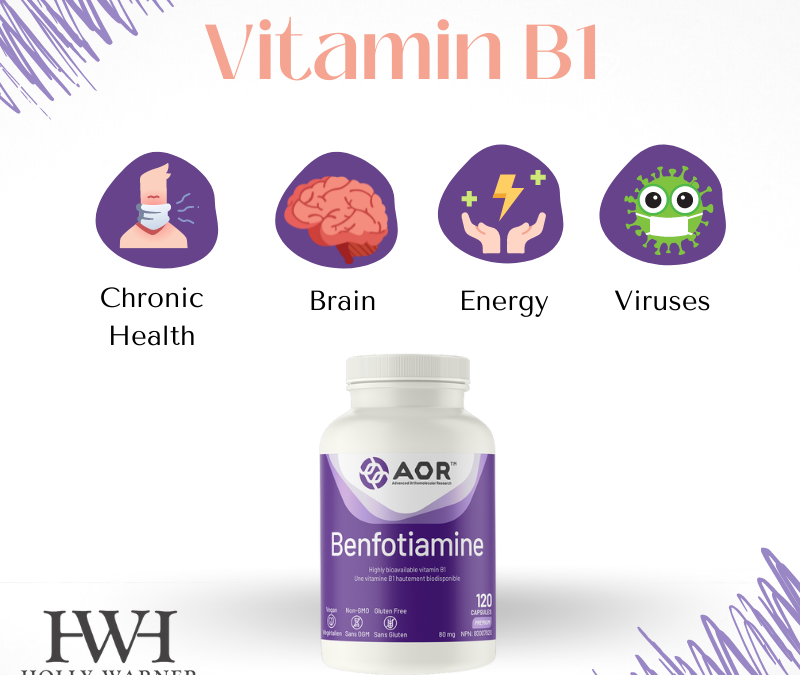We can all agree that our brain is pretty important. We protect it during sports, we relyon it’s function every single second. It’s there doing things even while we sleep. It stands to reason that we want to do everything possible to preserve and protect is functionality.
This is where Thiamine comes into play.
Thiamine = energy metabolism
Thiamine = enzyme production needed for Glutathione
Thiamine = ATP
Thiamine = enzyme production to protect against free radicals
Thiamine = protection against neural inflammation
Thiamine = healthy myelin sheath
Thiamine = Acetylcholine
Thiamine = traumatic brain injury prevention
Thiamine = protection from oxidative stress
Thiamine = GABA (calms) to Glutamate (stimulates) balance
In order to get rid of excess Glutamate we need to have adequate Thiamine. Rather than supplementing with GABA (which doesn’t cross the blood brain barrier) – I opt for recommending B1 instead to see how that helps with symptoms.
What do those symptoms look like?
For some it’s frazzled nerves, insomnia, anxiety, even presenting in a skitzophrenia like way. For others it could be mental cognition, memory, and thought processing.
Bodybuilders this one’s for you
Let’s discuss to main points.
- Lactic Acid
- Carbohydrate Consumption
Lactic Acid
Are you someone who is in the gym 5 days a week, HIIT (high intensity), weight training, or are an athlete and building up a lot of lactic acid?
If you are providing you body with the proper nutrients needed, the precursors required for the enzymes needed to control lactic acid production then you won’t experience this effect.
This brings us to the next part – the bodybuilders diet which is full of white rice and chicken – or carb loaded.
Carb consumption
This has two components. One has to do with genetic conditions, which we can test for here. The other has to do with a heavy carb loaded diet aka the bodybuilder diet. I’ve discussed this a bit in my previous article. By giving higher than average doses of specific nutrient, we are able to bypass some genetic conditions. Whether it was a deleted gene or a broken pathway. For example when we supplement with extra B1 we can trick the body into making more of a specific enzyme (pyruvate dehydrogenase) needed for a specific function (producing MORE ATP and LESS lactic acid).
MTHFR and how it relates to thiamine conversion
I mentioned above the genetic component. We know about methylated B vitamins, but it doesn’t end there. Personally my MTHFR is great, but further down that path is a messy MTR and MTRR – which means methylated B vitamins give me anxiety. I opt for adenosyl or hydroxy versions as a work around.
When we get thiamine from food, we break it down in the gut, we transport it to the cells where it’s needed. But we need a usable format, it needs to get converted. Pyrophosphate kinase is responsible for activating thiamine – however some polymorphisms mess with that. It doesn’t mean it won’t convert, it might just convert slower or at half the amount. This is something we watch closely from a clinical standpoint as it can mean that all of a sudden that bucket overflows and they crash – ending up with a chronic condition.
It’s not just about B1, but the most bioavailable form.
- Thiamine mononitrate – we can only absorb a certain amount at a time.
- Thiamine HCL (hydrochloride) – there are absorption issues here as well. It can be more for some and less for others.
- Benfotiamine – regarded as the best format supplementally – but it’s actually not.
- Allithiamine – a study out of japan has shown that this is far superior to any of the other forms out there.Not only is it absorbed better, it converts and is able to cross the blood brain barrier (unlike other versions). It can bypass essentially anything it needs to in order to get straight to where it needs to be. This includes bypassing the cell membrane of our gut, going right into our bloodstream. It’s been shown to increase the amount of thiamine by 10 to 100 times that of any other form. Down side? Because it is tied to a allicin molecule it had a horrific garlic odor.
- TTFD or Thiamine tetrahydrofurfuryl disulfide – they removed some of the sulfur component from the allicin molecules and rebranded as TTFD
- IV thiamine – this was the holy grail, except it still has limitations. It doesn’t get into the cells very well and it doesn’t cross the blood brain barrier.
This isn’t to say that if your genetics is doing its job that Benfotiamine isn’t still great, but if you can get your hands on TTFD it will get you the best result hands down.
What to watch for when buying your supplements
Fillers. I say it every time I recommend a product, watch the fillers. Not all brands are created equal. Look out for magnesium stearate, silicon dioxide, gluten, or any other fillers that can trigger an autoimmune reaction.
Stacking
What precursors are needed to utilize the full benefit of thiamine. We call these stacks or complementary supplementation. You need magnesium but not much else so be sure your supplement either has this added or you add it in the form of a stack (more than one supplement taken together for performance and function).
Which brand do I recommend? for TTFD Thiamax for Benfotiamine I like AOR which is available in my FullScript.






